TRAINS IN JAPANESE RAILWAYS
HOME
Train is perhaps the best way to get around Japan. Rail network is extensive and covers most cities in Japan. Usually fast, frequent, comfortable, though a bit expensive. Carriages are generally clean. I have never seen a graffitised nor vandalised train in Japan. The amenity of trains is being improved, still occasionally you may feel their layouts tight. Some trains (especially old types) were designed according to the relatively small physique of Japanese people or planned to fill the need to put many people in a limited capacity.
Japanese railway is also very reliable transport. Surely the most punctual in the world, and fairly safe. In the following Shinkansen system, there has never been a fatality in its more than thirty yearsf operation. The fare is not cheap, but Japan Rail Pass, much cheaper than the standards of the ordinal fare, is available to travelers from overseas.
Long-distance services are covered by Japan Railway (JR). Once it was one national railway (JNR, Japan National Railway). In 1986 it was privatised due to its surprisingly hefty debt more than 20 trillion yen, and separated into six regional passenger rail companies and one freight rail company. The result is successful on the whole, going into black and improving the services. When traveling, you do not care about the border of these JR companies because trains and tickets go through different companies as they were before separted.
Besides, there are other private railway companies. They usually operate trains between city and suburban areas; some of them extend 100 or 150 kilometers from Tokyo or Osaka to the sight-seeing spot outside city; for example, Tobu goes from Tokyo to Nikko, Odakyu to Hakone. Large cities also have subways under public management. Trams (streetcar) are not so common in Japan today because many of them have already abolished owing to traffic congestion. Still, several middle-sized cities have tram lines, Hakodate (Hokkaido), Hiroshima, Matsuyama, Kochi, Nagasaki, Kagoshima, and so on.
Shinkansen (High-speed bullet train)
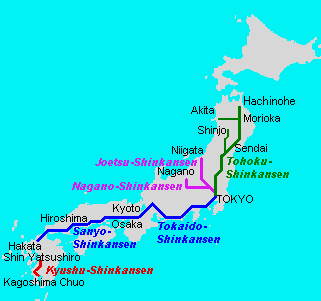 Shinkansen is famous for its high speed; actually it is not only fast, but very convenient and efficient. It is surely the busiest railway (in terms of intercity passenger transport) in the world. For example, when you go from Tokyo to Kyoto or Osaka, you don't have to care for time at all. Shinkansen trains departs every 5 to 15 minutes even in Sunday morning.
Shinkansen is famous for its high speed; actually it is not only fast, but very convenient and efficient. It is surely the busiest railway (in terms of intercity passenger transport) in the world. For example, when you go from Tokyo to Kyoto or Osaka, you don't have to care for time at all. Shinkansen trains departs every 5 to 15 minutes even in Sunday morning.
You can ride on Shinkansen without reservation (though you might have to stand in passage if seats are occupied), and train schedule is fairly frequent. So you can take Shinkansen at any time like subway without taking troublesome steps, which is a great advantage for busy Japanese businessmen. Some passengers run up the stairs to the platform and jump into the train just three seconds before the door closes.
Its scenery may be rather dull because everytime Shinkansen line comes to mountainous areas or even small hills, it goes straight into a long long tunnel to avoid curving, which is the obstacle to its high speed. You can hardly feel a sense of the train travel as a hobby or entertainment here. But anyway, Shinkansen plays very important role in Japan. Without this mass transit, densely-populated Tokaido megalopolis corridor will never function.
There are three kinds of carriages; Green car (the first class), reserved regular car (the second class), and non-reserved regular car which does not require advanced booking (see Tickets).
 On the train, usually attendants who sell you Ekiben (The station box lunch) and other snacks come frequently; and in many times the cafeteria car is conveyed. Ekiben is also
sold at many stations.
On the train, usually attendants who sell you Ekiben (The station box lunch) and other snacks come frequently; and in many times the cafeteria car is conveyed. Ekiben is also
sold at many stations.
All the Shinkansen trains are supplement payable. Japan Rail Pass holders do not have to pay it, though.
Tokyo - Nagoya - Kyoto - Shin(New) Osaka - Hirosima - Hakata
(Tokaido/Sanyo Shinkansen)
This line runs through the most densely populated areas of Japan. You may be surprised to see the train running at a top speed even if many many houses are crowded closely along the Shinkansen line. On weekdays, most seats are occupied with working people wearing gray suits. There are three kinds of services: 'Nozomi (Hope)', 'Hikari (Light)', and 'Kodama (Echo)'. Maximum speed is 270km/h in Tokaido Shikansen from Tokyo to Shin Osaka, and 285 or 300km/h in Sanyo Shinkansen from Shin Osaka to Hakata.
Nozomi is the fastest and only stops at large stations. Usually it stops at Shinagawa, Shin Yokohama, Nagoya, Kyoto, Shin Osaka, Shin Kobe, Okayama, Hiroshima and Kokura. Its supplement is higher than the other two kinds.
Note that Japan Rail Pass holders are not allowed to take Nozomi express (though this pass is valid to all other Shinkansen services).
Hikari stops at major stations, Kodama all stations. You should avoid Kodama unless you go to small stations because it is much slower than Nozomi and Hikari, though not so crowded as the former two. Stopping patterns vary from train to train (even in the same 'Hikari' category), and the timetable should be checked carefully.
|

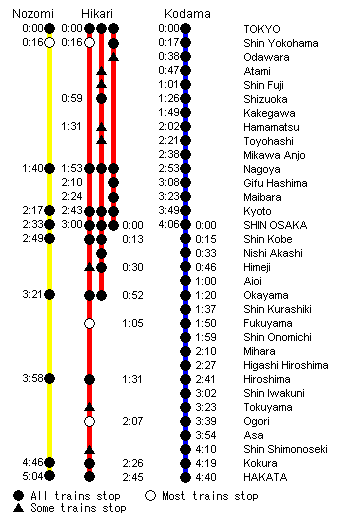
|
Tokyo - Sendai - Morioka - Hachinohe(Tohoku Shinkansen)
'Hayate' goes from Tokyo to Hachinohe, which is the fastest train of this line, the maximum speed is 275km/h and stops only large stations (usually Omiya, Sendai, Morioka and a few other stations). 'Yamabiko' goes from Tokyo to Sendai or Morioka, 'Nasuno' does not go so far and ends at Nasu-Shiobara or Koriyama. The maximum speed of 'Yamabiko' and 'Nasuno' is 240 km/h.
There are other two: 'Tsubasa' to Yamagata, Shinjo and 'Komachi' to Akita, they go through to a branch line (Yamagata Shinkansen and Akita Shinansen) from Tohoku Shinkansen line. Usually 'Tsubasa' is conveyed with 'Yamabiko' and 'Komachi' with 'Hayate' ; take a little care so as not to get on a wrong carriage.
'Hayate' and 'Komachi' does not have non-reserved car and you have to make reservation before your journey.
|
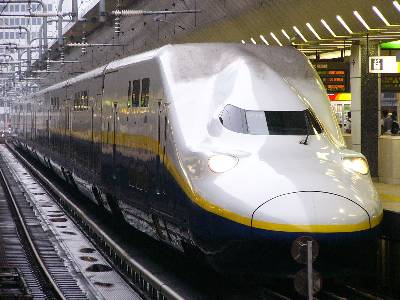
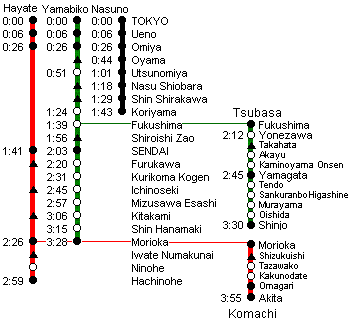
|
Tokyo - Takasaki - Nigata/Nagano (Joetsu Shinkansen / Nagano Shinkansen)
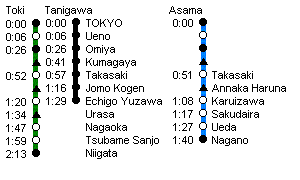 'Toki' goes from Tokyo to Nigata, 'Tanigawa' ends at Echigo-Yuzawa or Takasaki on the way. Almost all the middle part of this line going through the mountain ranges in the center of Honshu Island consists of tunnels and not different from a subway at all. In winter, the climate of northern and southern side of that mountain ranges are usually quite different owing to the barrier of high mountains. Southern side is usually sunny and little snow, but northern district is always covered with clouds and often snows quite heavily in winter. So cloudless sky with no snow may suddenly turn into dark sky with one meter's snowfall after Shinkansen rushes through long tunnels in just ten or twenty minutes. There are many large skiing grounds along Joetsu Shinkansen, very popular destination for people in Tokyo. A branch line, Nagano Shinkansen, goes from Takasaki to Nagano, and 'Asama' connects Tokyo and Nagano.
'Toki' goes from Tokyo to Nigata, 'Tanigawa' ends at Echigo-Yuzawa or Takasaki on the way. Almost all the middle part of this line going through the mountain ranges in the center of Honshu Island consists of tunnels and not different from a subway at all. In winter, the climate of northern and southern side of that mountain ranges are usually quite different owing to the barrier of high mountains. Southern side is usually sunny and little snow, but northern district is always covered with clouds and often snows quite heavily in winter. So cloudless sky with no snow may suddenly turn into dark sky with one meter's snowfall after Shinkansen rushes through long tunnels in just ten or twenty minutes. There are many large skiing grounds along Joetsu Shinkansen, very popular destination for people in Tokyo. A branch line, Nagano Shinkansen, goes from Takasaki to Nagano, and 'Asama' connects Tokyo and Nagano.
Shin Yatsushiro - Kagoshima Chuo (Kyushu Shinkansen)
Kyushu Shinkansen opened in 2004, and 'Tsubame' runs between Shin Yatsushiro and Kagoshima. It is only 40 minutes' short trip.
From Hakata (Fukuoka) to Shin Yatsushiro, 'Relay Tsubame' runs in conventional line and connects 'Tsubame' in Shin Yatsushiro. Passengers tranfer
in the same platform without taking trouble of walking long stairway and pathway, and trains are scheduled to tranfer two trains in only quick three minutes.
Kyushu Shinkansen from Hakata to Shin Yatsushiro is under construction, and will open in 2011. After that, they plan direct service from Shin Osaka to Kagoshima Chuo.
Limited express (Tokkyu)
 The limited express service covers most cities in Japan. As the topography of Japan is quite mountainous, they are not so fast (Maximum 130 km/h aside from few exceptions) but most of them provides fairly frequent services. With this, you can usually travel about 90 kilometers' journey per hour (60 or 70 km in the less important, low-grade line).
The limited express service covers most cities in Japan. As the topography of Japan is quite mountainous, they are not so fast (Maximum 130 km/h aside from few exceptions) but most of them provides fairly frequent services. With this, you can usually travel about 90 kilometers' journey per hour (60 or 70 km in the less important, low-grade line).
Most of them consist of the same three kinds of carriage as Shinkansen: Green car, reserved regular car and non-reserved regular car. Ekiben (The station box lunch) are usually available on board as well. It is a bit inconvenient that Shinkansen and other train services are completely separated because the rail gauge of Shinkansen and conventional railways is different. You may often have to change Shinkansen to a limited express at the junction if you extend your journey off the beaten track, although schedule is generally well organized and you have only to wait for several minutes at the connections.
They are supplement payable as well.
Express (kyuko)
Once there were many express trains, but now most of them have changed into Limited Express. (It is similar to the relation between 'Inter City' and 'Express' / 'D-Zug' in Europe.) Supplement is cheaper than the Limited express, but currently they can hardly be seen in major lines.
Overnight trains (Yako ressya/ 'Blue train' )
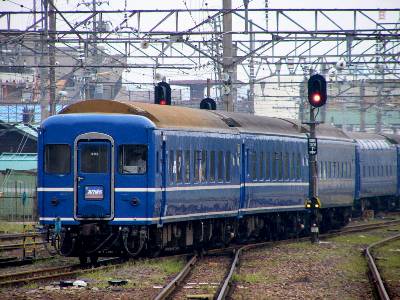 They are generally not very recommendable because the additional fare is high despite their poor amenity and slow speed. Now that much faster Shinkansen and air services as well as cheaper overnight highway bus become very common, overnight trains are not very useful measure to travel, at least in a practical sense.
They are generally not very recommendable because the additional fare is high despite their poor amenity and slow speed. Now that much faster Shinkansen and air services as well as cheaper overnight highway bus become very common, overnight trains are not very useful measure to travel, at least in a practical sense.
Sleeper cars require as much as 6,000 yen or even more expensive supplement even in the case of B-class carriages whose amenity are not so different from much cheaper 'couchette cars' in Europe. Although new type cars separated into small compartments by each one or two passengers and equipped with a key lock are available by paying only B-class fare in some trains.
(Luxurious Overnight trains in Japan)
Trains are sometimes regarded as a way to enjoy luxurious holidays rather than a mere practical transportation, such as 'Orient Express' in Europe or 'Indian Pacific' in Australia. In Japan, there are also a few overnight trains with luxurious facility.
'Cassiopeia' Tokyo (Ueno) - Sapporo
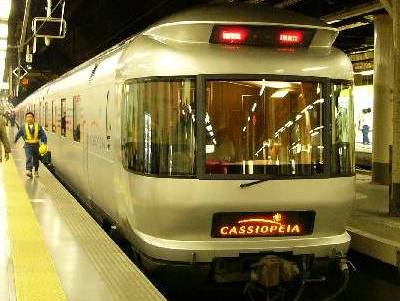 More Pictures
More Pictures
It is currently the most luxurious train in Japan, introduced in July 1999. It runs from Tokyo to Sapporo three days per week, about 1200 kilometers journey taking 17 hours. Carriges are all 'A-class' (first class) sleeper car without conveying standard B-class cars. The most delux car consists of only four rooms, which gives large and comfortable space to passengers. It also has a restaurant car which provides French or Japanese dinner, shower rooms and a observation lounge.
Sapporo and Hokkaido is one of the most popular holiday destination of Japanese, so there are two more overnight trains 'Hokutosei' from Tokyo to Sapporo everyday, which are also equipped with A-class delux sleeper cars and a restaurant car.
'Twilight Express' Osaka - Sapporo
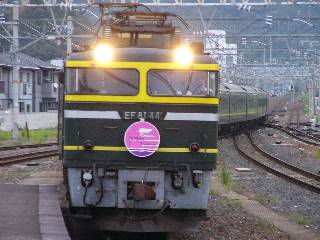
|
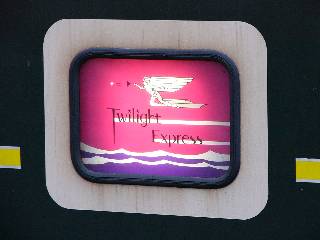
|
It runs along the coast line along Japan Sea about 1500 kilometers for 21 hours, three services per week (runs every day during the vacation season). It is named after the beautiful sunset at Japan Sea, although I heard once that the implication of the word 'twilight' is actually negative rather than positive (I am not so sure, is it true?). Anyway, its 'A-class' sleeper car has only five large luxurious compartments per carriage, whose additional fare is about 17,000 to 25,000 yen. This train also conveys one good restaurant car (though expensive) and another comfortable salon carriage.
(Overnight trains by Japan Rail Pass)
Compared with the case of Eurail pass, it seems more difficult for a Japan Rail Pass holder to use overnight trains as an alternative to stay in a hotel to save money. There are mainly two reasons; firstly, Japan is a bit too small to travel by overnight trains. Secondly, most overnight trains running between major cities consist of sleeper cars only, and do not convey standard class carriages which do not require supplement.
However, there are a few over night trains with standard class that Japan Rail Pass holders can get on without supplement.
- Sunrise Izumo (Tokyo - Matsue - Izumoshi))
- Sunrise Seto (Tokyo - Takamatsu)
All of the above does not carry non-reserved cars and requires reservation
. In several secondary lines, there are overnight trains that have standard cars, though they are usually short distance trains.
|
Local trains (Futsu ressya)
Local trains that stop almost all stations does not aim at transporting long distance travelers in general.
They are often not very comfortable. These days, the JR company tries to cut the costs of less profitable lines in the rural areas by saving the number of carriages. So even in countryside, local trains are sometimes as crowded as Yamanote Line in central Tokyo, though they convey only one or two cars. Their layout of seats is often not so different from that of subways in the city, which is suitable to pack as many passengers as possible in a limited space rather than providing comfortable seats.
However, using 'Seishun 18 kippu', special seasonal discount ticket for local trains, you can save the transport cost successfully, which is a popular way of travelling among young people in Japan. In addition, local train travel has other advantages. You may enjoy the scenery along the line better than the faster trains, surely more occasions to get in touch with Japanese people, and if you happen to find a nice town or outlook from the train, you can get on and off at any stations and walk around at will.
The frequency of local train varies from place to place. But apart from some areas around large or middle-sized cities and Tokaido-Sanyo (Tokyo - Osaka - Fukuoka) corridor, every two hours or even less. With local trains, you can usually travel about 50 to 60 kilometers' journey per hour in the case of major lines, about 40 km or less in the secondary lines.
More info about local train travel here!!
|
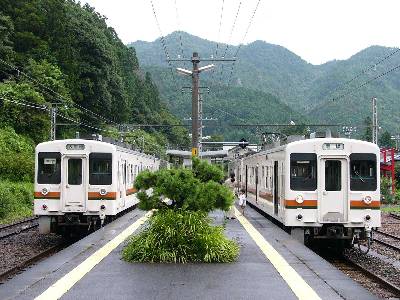
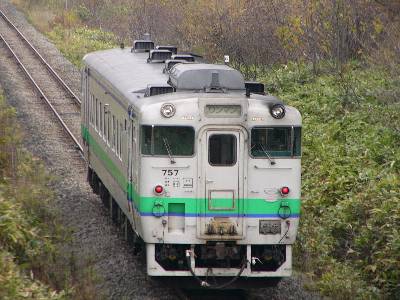
|
HOME
|
 Shinkansen is famous for its high speed; actually it is not only fast, but very convenient and efficient. It is surely the busiest railway (in terms of intercity passenger transport) in the world. For example, when you go from Tokyo to Kyoto or Osaka, you don't have to care for time at all. Shinkansen trains departs every 5 to 15 minutes even in Sunday morning.
Shinkansen is famous for its high speed; actually it is not only fast, but very convenient and efficient. It is surely the busiest railway (in terms of intercity passenger transport) in the world. For example, when you go from Tokyo to Kyoto or Osaka, you don't have to care for time at all. Shinkansen trains departs every 5 to 15 minutes even in Sunday morning.  On the train, usually attendants who sell you Ekiben (The station box lunch) and other snacks come frequently; and in many times the cafeteria car is conveyed. Ekiben is also
sold at many stations.
On the train, usually attendants who sell you Ekiben (The station box lunch) and other snacks come frequently; and in many times the cafeteria car is conveyed. Ekiben is also
sold at many stations.



 'Toki' goes from Tokyo to Nigata, 'Tanigawa' ends at Echigo-Yuzawa or Takasaki on the way. Almost all the middle part of this line going through the mountain ranges in the center of Honshu Island consists of tunnels and not different from a subway at all. In winter, the climate of northern and southern side of that mountain ranges are usually quite different owing to the barrier of high mountains. Southern side is usually sunny and little snow, but northern district is always covered with clouds and often snows quite heavily in winter. So cloudless sky with no snow may suddenly turn into dark sky with one meter's snowfall after Shinkansen rushes through long tunnels in just ten or twenty minutes. There are many large skiing grounds along Joetsu Shinkansen, very popular destination for people in Tokyo. A branch line, Nagano Shinkansen, goes from Takasaki to Nagano, and 'Asama' connects Tokyo and Nagano.
'Toki' goes from Tokyo to Nigata, 'Tanigawa' ends at Echigo-Yuzawa or Takasaki on the way. Almost all the middle part of this line going through the mountain ranges in the center of Honshu Island consists of tunnels and not different from a subway at all. In winter, the climate of northern and southern side of that mountain ranges are usually quite different owing to the barrier of high mountains. Southern side is usually sunny and little snow, but northern district is always covered with clouds and often snows quite heavily in winter. So cloudless sky with no snow may suddenly turn into dark sky with one meter's snowfall after Shinkansen rushes through long tunnels in just ten or twenty minutes. There are many large skiing grounds along Joetsu Shinkansen, very popular destination for people in Tokyo. A branch line, Nagano Shinkansen, goes from Takasaki to Nagano, and 'Asama' connects Tokyo and Nagano. The limited express service covers most cities in Japan. As the topography of Japan is quite mountainous, they are not so fast (Maximum 130 km/h aside from few exceptions) but most of them provides fairly frequent services. With this, you can usually travel about 90 kilometers' journey per hour (60 or 70 km in the less important, low-grade line).
The limited express service covers most cities in Japan. As the topography of Japan is quite mountainous, they are not so fast (Maximum 130 km/h aside from few exceptions) but most of them provides fairly frequent services. With this, you can usually travel about 90 kilometers' journey per hour (60 or 70 km in the less important, low-grade line).  They are generally not very recommendable because the additional fare is high despite their poor amenity and slow speed. Now that much faster Shinkansen and air services as well as cheaper overnight highway bus become very common, overnight trains are not very useful measure to travel, at least in a practical sense.
They are generally not very recommendable because the additional fare is high despite their poor amenity and slow speed. Now that much faster Shinkansen and air services as well as cheaper overnight highway bus become very common, overnight trains are not very useful measure to travel, at least in a practical sense. 



